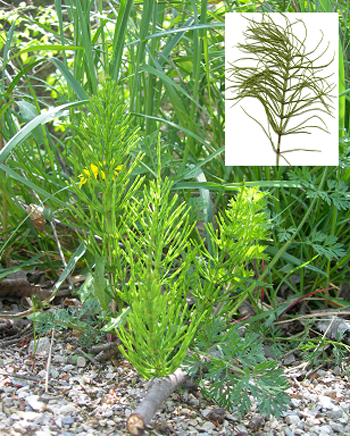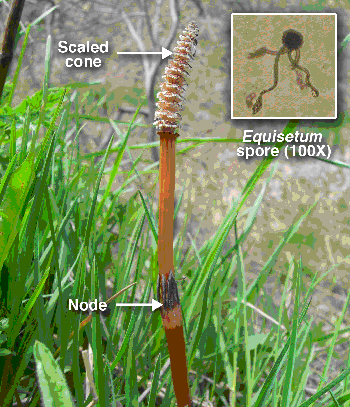Toxicity of equisetum to horses
Learn about horsetail poisoning in horses.
ISSN 1198-712X, Published July 2007
Introduction
Present and persistent since the Paleozoic era (250–540 million years ago), the plants of the genus Equisetum, commonly known as horsetail, are considered to be living fossils. These widespread, perennial, fern-like plants are found in most temperate areas of the world. They can have detrimental effects on horses if consumed in large quantities (for example, 2 kg (4–5 lb) per day for a 454-kg (1,000-lb) horse, for 1–2 weeks).
The presence of Equisetum in pasture is not a primary concern, as consumption at pasture is usually limited by the plant's high silicate content and the abundance of other palatable forage options. However, ingestion of contaminated hay can result in poisoning. If horsetail is cut, dried and mixed in with hay in moderate levels (20% or more of the horse's dry-matter intake

Clinical signs
Symptoms of Equisetum poisoning are seen primarily in young, rapidly growing horses, but cases of poisoning have also been reported in cows and sheep. The development of symptoms of Equisetum poisoning initiates slowly. The first signs may be a general, scruffy physical appearance, weight loss (without a particular loss of appetite), diarrhea and slightly uncoordinated movements. If not treated, the disease will progress to a point where the horse will show a loss of muscular control, staggering gait and extreme balance issues. The horse is prone to become uneasy and nervous due to its inability to control muscle movement. It may lie down and not be able to get up, may seizure, and may ultimately die from exhaustion within approximately 1-2 weeks
Treatment
Early identification of the symptoms is critical in the treatment of Equisetum poisoning. If caught early, the source of Equisetum can be removed, and a full recovery can be expected with appropriate treatment. Thiamine (vitamin B1) may be administered, 500 mg-1 g/day intravenously, then intramuscularly for several days

Identifying Equisetum
Equisetum species are often found on sandy and gravelly, wet soils, such as in marshes, wet meadows, and the banks of streams, lakes and ponds. Equisetum arvense (Figures 1 and 2), also known as field horsetail, is the most common and variable species of horsetail. Typically, E. arvense can be identified early in the season by the presence of its fertile stem, which is approximately 6 in. tall, brown/beige in colour and has nodes that are encompassed by long, dark, clasping leaf sheaths
Control
The plant's persistent, rhizomatous, rooting system and its ability to produce mass amounts of spores from the fertile stem, make eradication of Equisetum difficult. Draining excess water from marshy areas will help, while cutting the identified fertile stems in the early spring before spore distribution is an optimal way of decreasing future populations. Increasing the fertility of the soil and improving drainage will encourage cultivated grasses and legumes to grow and out-compete Equisetum. In addition, increasing grass and legume concentration will lower the Equisetum portion of the dry-matter intake in hay. Herbicides, such as 2,4-D and MCPA, control Equisetum species when applied to the vegetative portions
Footnotes
- footnote[1] Back to paragraph Kingsbury JM. Poisonous plants of the United States and Canada. Englewood Cliffs, New Jersey: Prentice-Hall, Inc., 1964:114-118.
- footnote[2] Back to paragraph Knight AP, Walter RG. A guide to plant poisoning of animals in North America. Jackson, Wyoming: Teton NewMedia, 2001:224-225.
- footnote[3] Back to paragraph Radostits OM, Gay CC, Blood DC, Hinchcliff KW. Veterinary medicine, 9th ed. Edinburgh: WB Saunders Company Ltd., 2000:1556-1558.
- footnote[4] Back to paragraph Burrows GE, Tyrl RJ. Toxic plants of North America. Ames, Iowa: Iowa State Press, 2001:434-438.
- footnote[5] Back to paragraph Cobb B. A field guide to the ferns. Boston: Houghton Mifflin Co., 1963:194-213.
- footnote[6] Back to paragraph Ontario Ministry of Agriculture, Food and Rural Affairs. Guide to weed control, 2006-2007, Publication 75. Toronto: Government of Ontario, 2006.